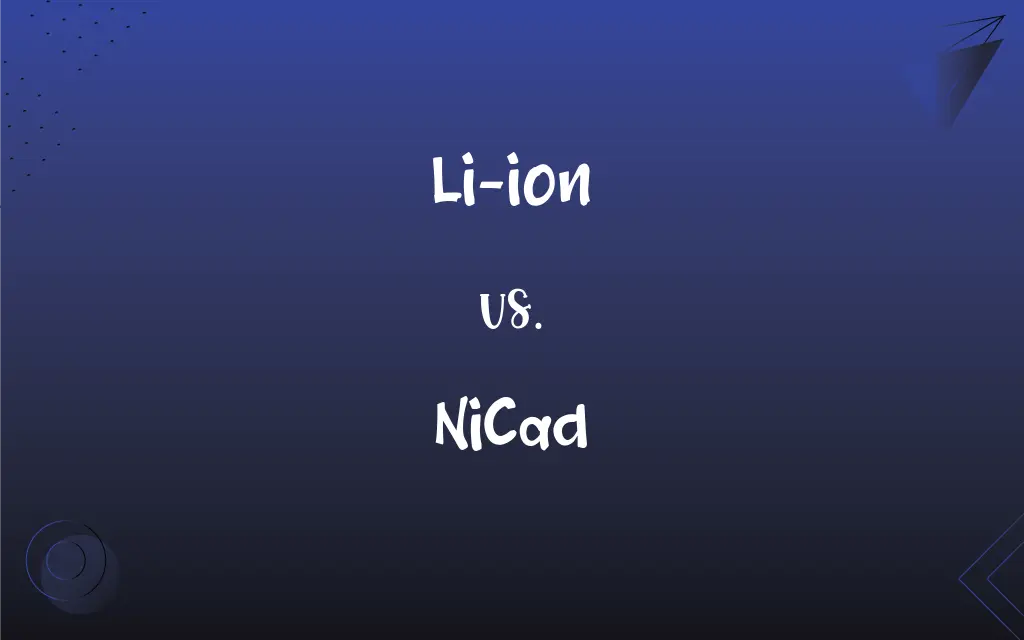Li-ion vs. NiCad: What's the Difference?
Edited by Aimie Carlson || By Janet White || Published on March 18, 2024
Li-ion batteries offer higher energy density and are lighter than NiCad batteries, which are older and suffer from memory effect.

Key Differences
Li-ion and NiCad batteries differ significantly in terms of energy density, with Li-ion batteries providing a much higher energy density. This means that Li-ion batteries can store more energy in the same amount of space compared to NiCad batteries, making Li-ion a preferred choice for portable electronics where weight and space are critical factors. NiCad batteries, on the other hand, are more robust and can perform better in colder temperatures.
The memory effect is another area where Li-ion and NiCad batteries differ. NiCad batteries suffer from a memory effect, which means that if they are repeatedly recharged after being only partially discharged, they may lose their maximum energy capacity. Li-ion batteries do not suffer from this memory effect, making them more convenient for users since they can be charged anytime without worrying about reducing their lifespan or capacity.
In terms of environmental impact, Li-ion batteries are considered more environmentally friendly than NiCad batteries. NiCad batteries contain cadmium, a toxic heavy metal that poses environmental risks if not disposed of properly. Li-ion batteries, while not entirely free of environmental impact, contain less toxic materials and are generally regarded as a more environmentally friendly option.
Lifespan and durability are also distinguishing factors between Li-ion and NiCad batteries. Li-ion batteries typically have a longer lifespan and can endure more charge cycles before their capacity starts to degrade significantly. NiCad batteries, while durable in their way, especially in terms of handling high discharge rates, tend to have a shorter overall lifespan compared to Li-ion batteries.
Cost is a factor where NiCad batteries might have an advantage, as they are generally cheaper to produce and purchase than Li-ion batteries. However, the lower cost of NiCad batteries may be offset by their shorter lifespan and the higher long-term value provided by Li-ion batteries, which offer longer use, higher efficiency, and lower environmental impact over their lifecycle.
ADVERTISEMENT
Comparison Chart
Energy Density
Higher, offering more power per unit of weight
Lower, less energy-dense
Memory Effect
No memory effect, can be charged anytime
Suffers from memory effect, affecting battery capacity
Environmental Impact
Less toxic materials, more environmentally friendly
Contains cadmium, a toxic heavy metal, posing disposal issues
Lifespan
Longer lifespan with more charge cycles
Shorter lifespan compared to Li-ion
Cost
Generally more expensive due to higher performance
Cheaper initially but may incur more cost over time
ADVERTISEMENT
Li-ion and NiCad Definitions
Li-ion
Known for not having a memory effect, allowing flexible charging.
I appreciate how my Li-ion laptop battery doesn't suffer from memory effect.
NiCad
A type of rechargeable battery known for its robustness and durability.
My cordless drill uses a NiCad battery because it's tough and reliable.
Li-ion
Offers a longer lifespan and more charge cycles.
The Li-ion battery in my camera lasts longer and supports more recharges than older types.
NiCad
Generally cheaper than Li-ion but with lower energy density.
NiCad batteries are more affordable, but I need more of them for the same power output.
Li-ion
A type of rechargeable battery with high energy density.
My smartphone uses a Li-ion battery for longer usage between charges.
NiCad
Prone to memory effect, requiring full discharges before recharging.
I have to regularly deep discharge my NiCad batteries to prevent memory effect.
Li-ion
Generally more expensive but provides higher performance.
Despite the higher cost, I prefer Li-ion batteries for their efficiency and durability.
NiCad
Contains cadmium, a toxic element requiring careful disposal.
Disposing of my old NiCad batteries requires special attention due to the cadmium content.
Li-ion
Contains less toxic materials compared to some other battery types.
Choosing Li-ion batteries is a more environmentally friendly option for my gadgets.
NiCad
Performs well in cold temperatures, suitable for outdoor tools.
My outdoor equipment uses NiCad batteries for their cold-weather performance.
NiCad
(electronics) rechargeable nickel-cadmium battery
NiCad
A rechargeable battery with a nickel cathode and a cadmium anode; often used in emergency systems because of its low discharge rate when not in use
FAQs
Why do NiCad batteries have a memory effect?
The memory effect in NiCad batteries is due to repeated partial discharges that lead to decreased capacity.
Is it safe to dispose of Li-ion batteries in regular trash?
No, Li-ion batteries should be recycled or disposed of according to local regulations due to their chemical components.
How do NiCad batteries perform in cold weather?
NiCad batteries are known for their good performance in cold temperatures.
What does Li-ion stand for?
Li-ion stands for Lithium-ion.
Why are NiCad batteries cheaper than Li-ion?
NiCad batteries are cheaper due to simpler technology and lower production costs.
What is the main advantage of Li-ion over NiCad?
Li-ion batteries have a higher energy density and no memory effect.
Can Li-ion batteries be charged at any time?
Yes, Li-ion batteries can be charged at any state without affecting their lifespan.
Can NiCad batteries be used in smartphones?
NiCad batteries are generally not used in smartphones due to their lower energy density and memory effect.
Are Li-ion batteries environmentally friendly?
Li-ion batteries are considered more environmentally friendly than NiCad due to less toxic materials.
Do Li-ion and NiCad batteries use the same charger?
No, they require different chargers due to their differing charging requirements.
Why might someone choose a NiCad battery over Li-ion?
Someone might choose NiCad for its durability, especially in high-drain devices and cold environments.
How long do Li-ion batteries last compared to NiCad?
Li-ion batteries typically have a longer lifespan and endure more charge cycles.
What are the typical uses for NiCad batteries?
NiCad batteries are often used in power tools, emergency lighting, and medical equipment.
Can NiCad batteries be recycled?
Yes, NiCad batteries can and should be recycled due to their toxic cadmium content.
Can the memory effect in NiCad batteries be reversed?
The memory effect can sometimes be reduced by fully discharging and then recharging the battery several times.
Are Li-ion batteries lighter than NiCad?
Yes, Li-ion batteries are lighter due to their higher energy density.
What happens if a Li-ion battery is overcharged?
Overcharging a Li-ion battery can lead to overheating and potentially cause it to fail or catch fire.
Do all Li-ion batteries have the same lifespan?
Lifespan varies depending on usage, charging habits, and quality of the battery.
Are there any advancements in Li-ion technology?
Li-ion technology is continually advancing, with improvements in energy density, safety, and longevity.
What is the impact of deep discharging a NiCad battery?
Deep discharging can help mitigate the memory effect in NiCad batteries.
About Author
Written by
Janet WhiteJanet White has been an esteemed writer and blogger for Difference Wiki. Holding a Master's degree in Science and Medical Journalism from the prestigious Boston University, she has consistently demonstrated her expertise and passion for her field. When she's not immersed in her work, Janet relishes her time exercising, delving into a good book, and cherishing moments with friends and family.
Edited by
Aimie CarlsonAimie Carlson, holding a master's degree in English literature, is a fervent English language enthusiast. She lends her writing talents to Difference Wiki, a prominent website that specializes in comparisons, offering readers insightful analyses that both captivate and inform.







































































